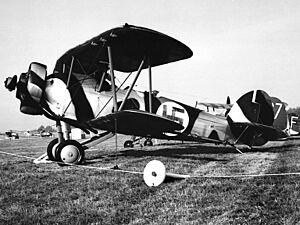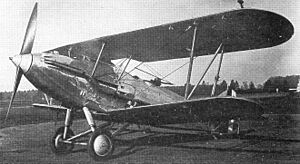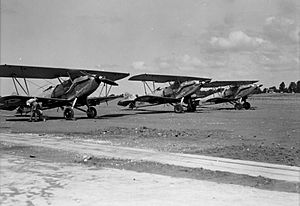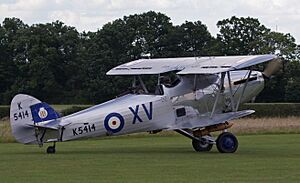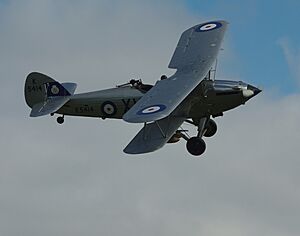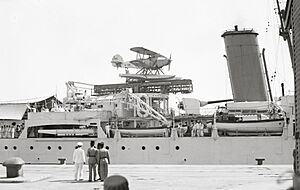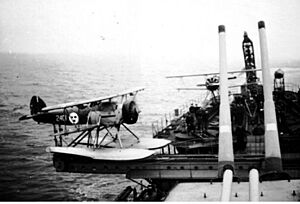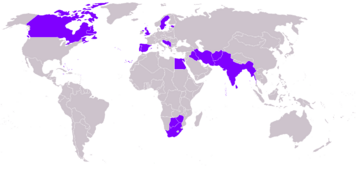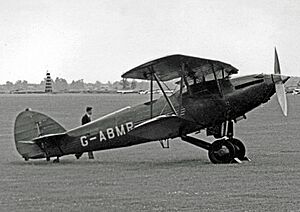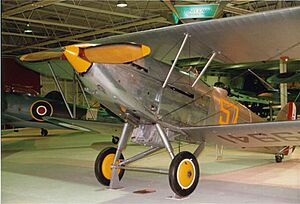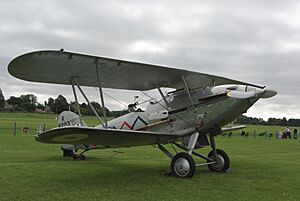Hawker Hart facts for kids
Quick facts for kids Hart |
|
|---|---|
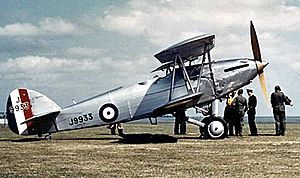
Hawker Hart G-ABMR
|
|
| General information | |
| Type | Light bomber |
| Manufacturer | Hawker Aircraft Limited |
| Designer | |
| Primary user | Royal Air Force |
| History | |
| Introduction date | 1930 |
| First flight | June 1928 |
| Retired | 1943 |
| Developed into | Hawker Hind Hawker Hector |
The Hawker Hart was a British two-seater airplane. It was a biplane, meaning it had two main wings stacked one above the other. This aircraft was designed as a light bomber and served with the Royal Air Force (RAF).
Sydney Camm designed the Hart in the 1920s. It was built by Hawker Aircraft. The Hart was very important between the two World Wars. However, by the start of World War II, it was considered old. Newer monoplane aircraft (with one main wing) had taken its place. The Hart played only small roles in the war before it was retired in 1943.
Many different versions of the Hart were made. This included a special version for the Royal Navy's aircraft carriers. Besides Britain, several other countries used the Hart. These included Sweden, Yugoslavia, Estonia, South Africa, and Canada.
Contents
Designing the Hawker Hart
In 1926, the Air Ministry asked for a new two-seat bomber. They wanted it to be fast and made of metal. It needed to fly at least 160 miles per hour (258 km/h). Companies like Hawker, Avro, and de Havilland sent in their designs.
Hawker's design was a biplane. It used a powerful Rolls-Royce Kestrel engine. The plane's body was made of steel tubes covered with metal panels and fabric. Its wings had steel parts and were covered in fabric.
The Hart had two seats, one behind the other. The pilot sat in front and controlled a machine gun. The second person was an observer. They used another machine gun and also helped aim bombs. The plane could carry up to 520 pounds (240 kg) of bombs under its wings.
First Flight and Testing
The first Hart prototype, named J9052, flew in June 1928. It was tested on September 8. The plane showed great speed and was easy to fly. It could reach 176 mph (283 km/h) in level flight. It even hit 282 mph (454 km/h) in a dive!
In April 1929, the Hawker Hart was chosen as the winner. Other designs were not picked. The Hart was also much cheaper to keep and repair. This was very important because of money limits in the 1920s.
Production and Speed
A total of 992 Harts were built. It became the most used light bomber of its time. The Hart's design was so good that it led to other planes. These included the Hawker Hind and the Hawker Hector.
The production Hart bomber had a 525 horsepower (390 kW) Rolls-Royce Kestrel engine. It could fly at 184 mph (296 km/h). Its range was 470 miles (757 km). Amazingly, it was faster than most fighter planes of its time! This made the Hart one of the best biplane bombers for the RAF.
Because it was so fast, the RAF had to replace its slower Bristol Bulldog fighters. They brought in the faster Hawker Fury to keep up. Many companies helped build the Hart. This included Hawker, Armstrong Whitworth, Gloster, and Vickers. Sweden also built 42 Harts under license. In total, 1004 Harts were produced.
Hawker Hart in Action
The Hart started serving with No. 33 Squadron RAF in February 1930. It replaced older, slower planes. Other squadrons also began using Harts in 1931.
Harts were sent to the Middle East during the Abyssinia Crisis in 1935–1936. They also saw a lot of action in British India. Four Hawker Harts from the Swedish Air Force were used as dive bombers. This was during the 1939–1940 Winter War in Finland.
Even though it was old by World War II, the Hart kept flying. It was mainly used for training and carrying messages. It was officially retired in 1943.
Export and Dive Bombing
The Hart was also sold to many other countries. These included the Royal Egyptian Air Force, Royal Indian Air Force, South African Air Force, Estonian Air Force, Southern Rhodesia, Sweden, and Kingdom of Yugoslavia. Rhodesian Harts fought on the Allied side in East Africa during World War II.
A Swedish Air Force general, Björn Bjuggren, wrote about how his squadron learned to dive-bomb with their Harts. Hawker engineers were worried because the plane wasn't designed for it. But the Swedish pilots showed that the Hart could handle it!
Different Versions of the Hart
Hart Variants
- Hart I: The main two-seat light bomber for the RAF.
- Hart (India): A version for hot climates, used in India. It had a bigger radiator and extra gear.
- Hart (C): An unarmed two-seat plane for communications.
- Hart Trainer: A two-seat plane used for training pilots.
- Hart Fighter: A two-seat fighter version for the RAF. It was later called the Demon.
- Hart (Special): Another version for hot climates, used in the Middle East.
- Estonian Hart: An export version for Estonia. It could use wheels or floats for landing.
- Swedish Hart: Light bombers for the Swedish Air Force. They used a different engine, the Bristol Pegasus.
Hawker Audax
The Hawker Audax was a Hart version made for working with the army. It was used a lot across the British Empire. The first Audax flew in late 1931. Over 700 Audaxes were built. It looked like the Hart but had special changes. For example, it had a hook to pick up messages from the ground.
The Audax had two machine guns. It could fly up to 170 mph (274 km/h). Many versions were made, like the Audax India for service in India.
Other countries that used the Audax included Canada, India, South Africa, Egypt, Iraq, and Iran. During World War II, the Audax saw limited action in Africa. It also fought in Iraq during the Anglo-Iraqi War. Crews even upgraded their Audaxes to carry heavier bombs for that battle.
The Audax stopped serving by 1945. A plane called the Hawker Hartebeest was made from the Audax. It was a light bomber for the South African Air Force. Most of the 69 Hartebeests were built in South Africa. They saw action in East Africa.
- Audax I: Two-seat army cooperation aircraft for the RAF.
- Canadian Audax: A modified version for the Royal Canadian Air Force.
- Egyptian Audax: Aircraft fitted with a powerful Armstrong Siddeley Panther engine.
- Iraqi Audax (Nisr): Aircraft fitted with a Bristol Pegasus engine.
- Persian Audax: Aircraft fitted with Pratt & Whitney Hornet or Bristol Pegasus engines.
- Hartebeest: A general-purpose plane for the South African Air Force.
Hawker Demon
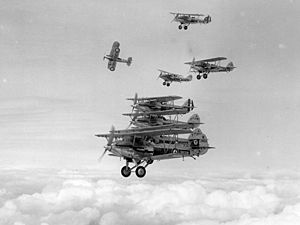
The Hawker Demon was a fighter version of the Hart bomber. During practice flights, older RAF fighters often couldn't catch the new Hart bombers. This led to the idea of making a fighter version of the Hart.
The Demon added a second machine gun. It also had a more powerful engine. Tests in 1931 were successful. More orders followed for this new fighter, now called the Hawker Demon. The first production Demon flew on February 10, 1933.
305 Hawker Demons were built, with 232 for the RAF. They used different versions of the Kestrel engine. The Demon had three machine guns: two in the front and one in the back. Many Demons had a special power-driven turret for the rear gunner. Demons were also sold to the Royal Australian Air Force. They saw only minor action in World War II.
- Demon I: Two-seat fighter aircraft for the RAF.
- Australian Demon I: Fighter aircraft for the RAAF, similar to the RAF version.
- Australian Demon II: A training version for the RAAF with dual controls.
- Turret Demon: A fighter version with a special shield to protect the rear gunner.
Hawker Hardy
The Hawker Hardy was a version of the Hart made for general use in hot climates. It was designed to replace another plane in Iraq. The first Hardy flew on September 7, 1934. The first planes were delivered in January 1935.
The Hardy saw some action in World War II in Africa and the Middle East. It flew missions against Italian forces in Abyssinia (now Ethiopia). The Hardy also served with Southern Rhodesia. The last mission by a Hardy was on May 9, 1941. Most surviving Hardys were scrapped. One Hardy was even used by Belgian forces for observation.
- Hardy I: Two-seat general-purpose aircraft for the RAF.
Hawker Hind
The Hawker Hind was a plane developed from the Hart. It was meant to replace the Hart. The Hawker Hector was another version of the Hind. It was used to help the army. The Hind saw only limited service with the RAF during World War II. Hectors were also sold to Ireland.
Hawker Osprey
The Hawker Osprey was the naval version of the Hart. It was designed to fly from aircraft carriers. It worked as both a fighter and a reconnaissance (scouting) plane. The Osprey had a Rolls-Royce Kestrel engine. It could fly at a top speed of 168 mph (270 km/h).
The Osprey had two machine guns. It joined the Fleet Air Arm (FAA) in 1932. A total of 103 Ospreys were built. It served until 1944, mainly as a trainer for FAA pilots during World War II. Ospreys were also sold to the Swedish Air Force. They were used on the seaplane cruiser HSwMS Gotland. Portugal and the Spanish Republican Air Force also bought Ospreys.
- Osprey I: Two-seat fleet spotter and reconnaissance aircraft.
- Osprey II: Similar to Osprey I, but with new floats.
- Osprey III: Had a dinghy (small boat) stored in the wing.
- Osprey IV: A later version with a more powerful engine.
- Portuguese Osprey: Aircraft built for Portugal.
- Spanish Osprey: One aircraft built for the Spanish Republican Air Force.
- Swedish Osprey: Version for Sweden with a different engine and interchangeable landing gear.
Who Used the Hart and Its Variants?
Hawker Hart Users
 Afghanistan
Afghanistan Canada
Canada Egypt
Egypt Estonia
Estonia British India
British India Iran
Iran South Africa
South Africa Southern Rhodesia
Southern Rhodesia Sweden
Sweden United Kingdom
United Kingdom Kingdom of Yugoslavia
Kingdom of Yugoslavia
Hawker Audax Users
 British India
British India Canada
Canada Egypt
Egypt Iraq
Iraq Iran
Iran Southern Rhodesia
Southern Rhodesia Straits Settlements
Straits Settlements United Kingdom
United Kingdom
Hawker Demon Users
 Australia
Australia United Kingdom
United Kingdom
Hawker Hardy Users
 United Kingdom
United Kingdom Southern Rhodesia
Southern Rhodesia Belgium
Belgium Belgian Congo
Belgian Congo
Hawker Hartebeest Users
Hawker Osprey Users
 Portugal
Portugal Spanish Republic
Spanish Republic Sweden
Sweden United Kingdom
United Kingdom
Surviving Aircraft
You can still see some of these historic planes today!
Australia
- A1-8 – A Demon I is on display at the RAAF Museum in Point Cook, Victoria. It was delivered in 1935 and restored in 1987.
Sweden
- 714 – A B 4 (Swedish Hart) is on display at the Swedish Air Force Museum near Linköping.
United Kingdom
- G-ABMR – A Hart II is on display at the Royal Air Force Museum London. This plane never saw military use. It was used by Hawker for testing and demonstrations. It flew until 1971 and is now painted to look like an RAF Hart.
- K4972 – A Hart Trainer is on display at the Royal Air Force Museum Cosford. It was built in 1935 and used for training.
United States
- K8203 – A Demon is airworthy and was previously part of the Shuttleworth Collection in Old Warden.
Hawker Hart Specifications
Here are some facts about the Hart day bomber (with the Kestrel IB engine):
- Crew: 2 people
- Length: 29 feet 4 inches (8.94 meters)
- Wingspan: 37 feet 3 inches (11.35 meters)
- Height: 10 feet 5 inches (3.18 meters)
- Wing Area: 349.5 square feet (32.47 square meters)
- Empty Weight: 2,530 pounds (1,148 kg)
- Max Takeoff Weight: 4,596 pounds (2,085 kg)
- Fuel Capacity: 83 Imperial gallons (377 liters)
- Engine: 1 × Rolls-Royce Kestrel IB water-cooled V12 engine, 525 horsepower (390 kW)
- Maximum Speed: 185 mph (298 km/h) at 13,000 feet (4,000 meters)
- Stall Speed: 45 mph (72 km/h)
- Range: 430 miles (692 km)
- Ceiling: 22,800 feet (6,900 meters)
- Climb Rate: Could reach 10,000 feet (3,000 meters) in 8 minutes 30 seconds
- Guns:
- 1 × forward-firing .303 inch (7.7 mm) Vickers machine gun
- 1 × .303 inch (7.7 mm) Lewis Gun in the back cockpit
- Bombs: Up to 520 pounds (240 kg) of bombs under the wings
More to Explore
- Aircraft related to this one
- Hawker Hind
- Lists related to this aircraft
- List of aircraft of World War II
- List of aircraft of the Spanish Republican Air Force
See also
 In Spanish: Hawker Hart para niños
In Spanish: Hawker Hart para niños


